

| Newsletter English August/September |

|

|





ICRANet Newsletter
ICRANet Newsletter
August - September 2015
SUMMARY
- Signed new collaboration agreement in Brazil - ICRANet Brazilian Science Data Center Symposium - The Report of the International Conference on Gravitation and Cosmology (ICGC) /the fourth Galileo-Xu Guangqi meeting (GX4) - ICRANet participation in the European Researchers' Night 2015 - Recent publications and proceedings - Upcoming conferences
New collaboration agreement in Brazil

The new agreement has been signed between ICRANet and University of Brasilia (UnB) on September 4, in Brasilia (Brazil) by the Director of ICRANet, prof. Remo Ruffini and the Deputy Rector of UnB, prof. Sonia Nair Bao witnessed by the Director of the Institute of Physics, prof. Jose Felippe Beaklini Filho and the Director of the International Cooperation Office Eiiti Sato. For details see here
ICRANet Brazilian Science Data Center Symposium
Institute of Physics, Federal University of Rio Grande do Sul (UFRGS)
September 03, 2015 - PORTO ALEGRE, BRAZIL 
In the context of the implementation and start of activities of the ICRANet Brazilian Science Data Center (ICRANet-BSDC), (http://bsdc.icranet.org) at Centro Brasileiro de Pesquisas Físicas - CBPF and Universidade Federal do Rio Grande do Sul - UFRGS, in view of the collaboration with the Italian Space Agency Science Data Center (ASI-ASDC), ICRANet has promoted the Brazilian Science Data Center Symposium on September 03, 2015, in the Physics Institute of the Federal University of Rio Grande do Sul, Porto Alegre Brazil.


The Brazilian Science Data Center (BSDC) is the project for a new Astronomical Database, built according to the concepts of the ASDC (www.asdc.asi.it/), from the Italian Space Agency (ASI). It will consist on an extensive archive of astrophysical data from several MWL space missions and ground-based observatories, from radio to gamma-rays, along with supporting software for online data mining, investigation and analysis, as well as personnel for technical support, tools development and research. The project has institutional support from all ICRANet Centers in Armenia, Italy and the Vatican and both from CBPF and UFRGS and is currently in early development phase. The BSDC will be open to all Universities and Research Centers of Brazil who have signed collaboration agreement with ICRANet. The operation of the BSDC should start by the end of the year, with full capacity operation scheduled for 2017.

Apart from reproducing most of the data-sets and tools already available at ASDC, the BSDC wishes to develop some unique and innovative features, both in terms of analysis software and data mining tools, as well as regarding the content of its database.
The purpose of the meeting was to present the BSDC to the astronomical community and to discuss and coordinate the technical and operational aspects between the teams of CBPF and UFRGS. We also aimed to discuss and hear from the community about potential scientific proposals to the BSDC. For this reason, the meeting has assembled scientists from ICRANet, ASI and all Brazilian Institutions involved or planning to collaborate with the BSDC and at the same time to pursue collaborations at the local level in order to strengthen the project of the BSDC. This one-day Symposium of preparation to the start of activities of the BSDC was very successful, with significant participation of Brazilian researchers at the local level and through the internet.
The Report of the International Conference on Gravitation and Cosmology (ICGC) /the fourth Galileo-Xu Guangqi meeting (GX4)

This year is the 100th anniversary of Albert Einstein's presentation of General Relativity. To celebrate the big event, in May 4-8, the International Conference on Gravitation and Cosmology (ICGC) /the fourth Galileo-Xu Guangqi meeting (GX4) was held at the Institute of Theoretical Physics, University of Chinese Academy of Sciences. The goal of the conference was to bring the leading scientists working on gravitation, cosmology and relativistic astrophysics together, to review the current status and to present further directions in gravity, cosmology and relativistic astrophysics, and to promote relevant researches in China.

In the first day of the conference, the Marcel Grossmann Award Ceremony was held. The awardees are the well-known theoretical physicists, Nobel laureates in physics, Prof. T.D. Lee, and Prof. C.N Yang. In the ceremony, Prof. C.N. Yang gave a speech. The vice-president of Chinese Academy of Sciences, Prof. Ya-Ping Zhang gave a welcome speech. More than 300 participants took part in the ceremony.
Over the past 100 years, general relativity has passed various precise tests from the sub millimeter scales to the solar scales, and even to the cosmic scales. Indeed, based on general relativity, the concordance model of the universe, namely the LCDM model, is consistent with all current observational data. The concordance model says that our universe has underwent a quasi-exponential expansion in the very early time, current universe consists of about 5% baryonic matter, 27% dark matter and 68% dark energy. However, it is fair to say that a successful inflation model from some fundamental theory, the properties of dark matter and the nature of dark energy remain as challenges to us. 
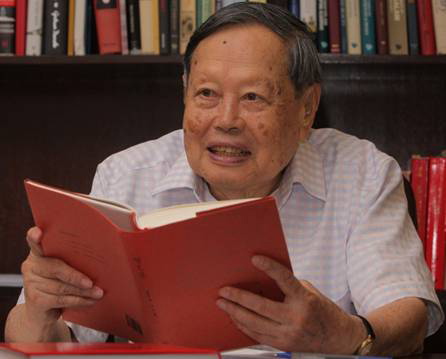
Since the third Marcel Grossmann meeting (MGIII) in Shanghai in 1982 there has been a continuous and vigorous development of Relativistic Astrophysics in China. In this ICGC-GX4-MGXIV joint meeting most significant contributions have evidenced the moment of the birth of a Black Hole in GRBs, triggered by Supernovae. Observations from a Chinese telescope in Yunan have discovered the largest yet observed Black Hole in the Universe, of 12 Billions solar masses. Further discoveries from Chinese radio astronomy telescopes, X and Gamma Ray satellites, cosmic rays detectors in Tibet, as well as the underground experiments in the Sichuan JinPing tunnel near the celebrated Yang-Tze gorges, are soon expected.
It is an essential progress in understanding the nature of gravity from Newtonian gravity to Einstein's general relativity. Motivated by black hole thermodynamics, G. 't Hooft proposed in 1993 that gravity is of the so-called holographic property. The holographic principle might be one of fundamental principles of Nature. However, the true nature of gravity is still absent. Just as reported by the journal "Science" in 2015, the nature of gravity remains as one of 125 unsolved important problems in Nature. During the five days conference, more than 40 invited speakers gave talks with high quality covering various topics from inflation, dark matter, dark energy, black hole physics, relativistic astrophysics, numerical relativity gravitational wave, string theory to loop quantum gravity etc. The conference was cosponsored by the State Key Laboratory of Theoretical Physics (SKLTP/ITP-CAS), Kavli Institute for Theoretical Physics China (KITPC/ITP-CAS), Chinese Society of Gravitation and Relativistic Astrophysics, International Center for Theoretical Physics-Asian Pacific (ICTP-AP), Chinese Center for Advanced Science and Technology (CCAST), Yunnan Observatories at Chinese Academy of Sciences, Department of Astronomy at the University of Science and Technology of China, International College of University of Chinese Academy of Sciences (IC-UCAS), the Theoretical Physics Center for Science Facilities (TPCSF) at the Chinese Academy of Sciences (CAS), and ICRANet. Some talks of the conference can be downloaded through the websites: http://www.itp.cas.cn/xshd/xshy/201501/t20150122_4303028.html http://www.icranet.org/index.php?option=com_content&task=view&id=918# 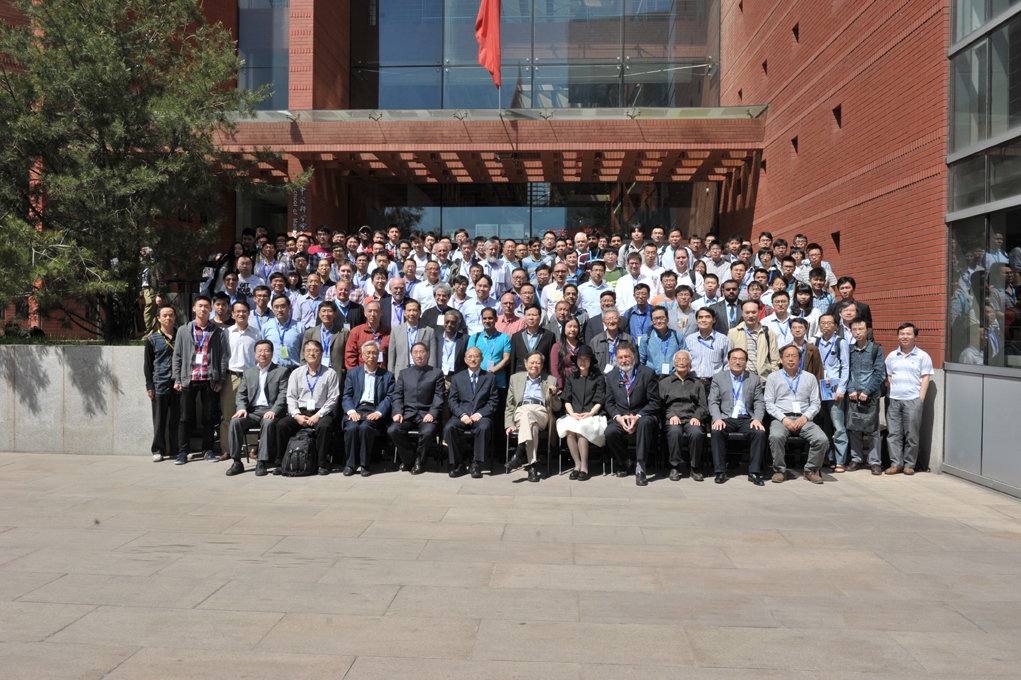
ICRANet participation in the European Researchers' Night 2015
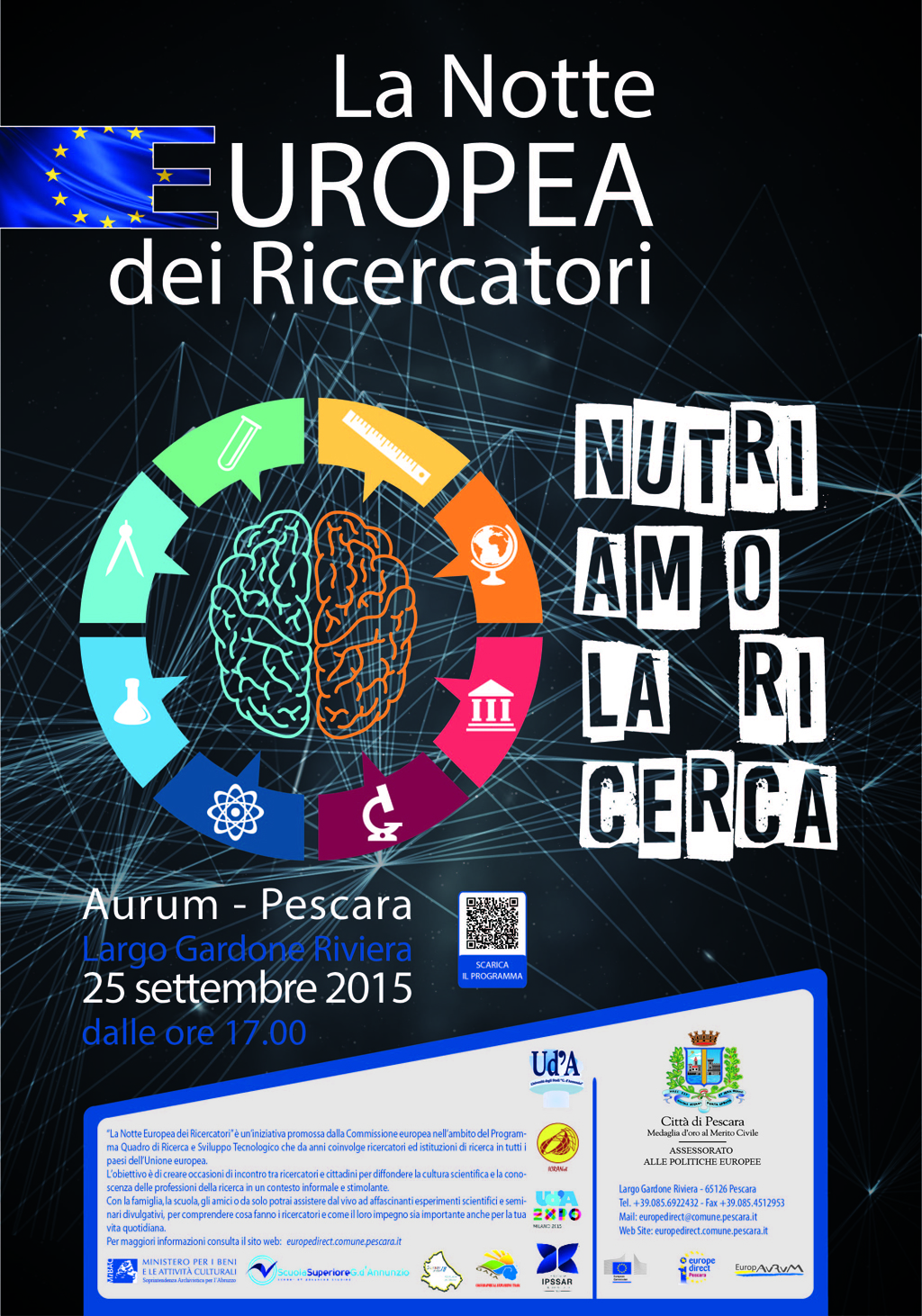
This year Comune of Pescara, through Europe Direct, in collaboration the University “G. d’Annunzio” of Chieti-Pescara and ICRANet again organized “European Researchers' Night”, the initiative of REA (Research Executive Agency) which celebrates its 10th anniversary this year. This mega event attracts over 1 million people every year and offers visitors a unique opportunity to meet researchers and take part in science activities aiming to showcase both the fascination of research as a career and its significant societal impact.
The program of this event (in Italian) can be found here 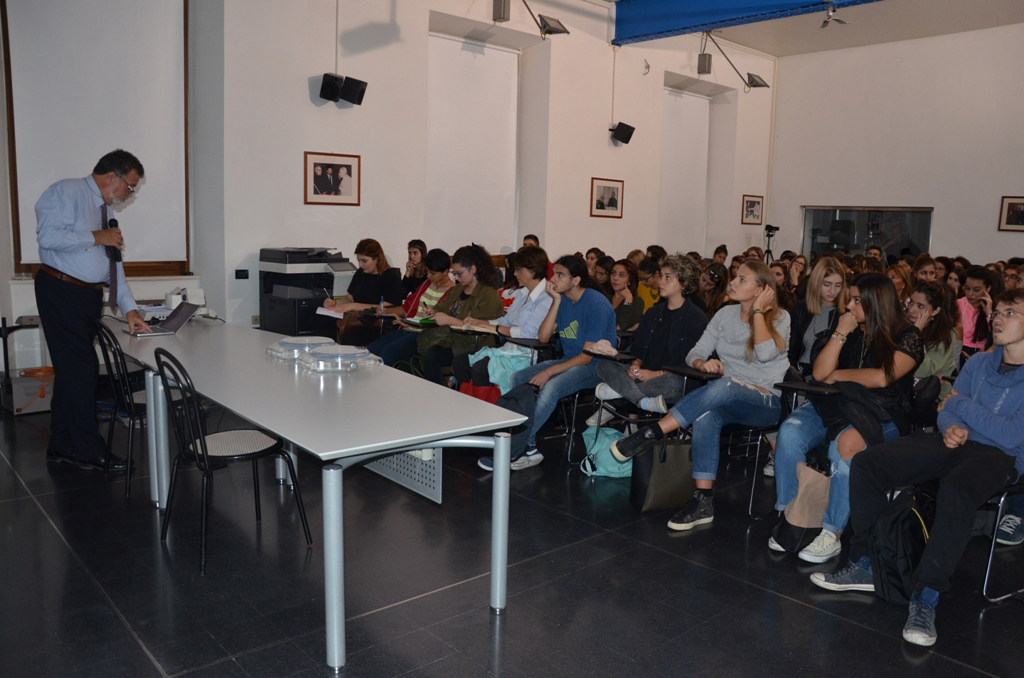
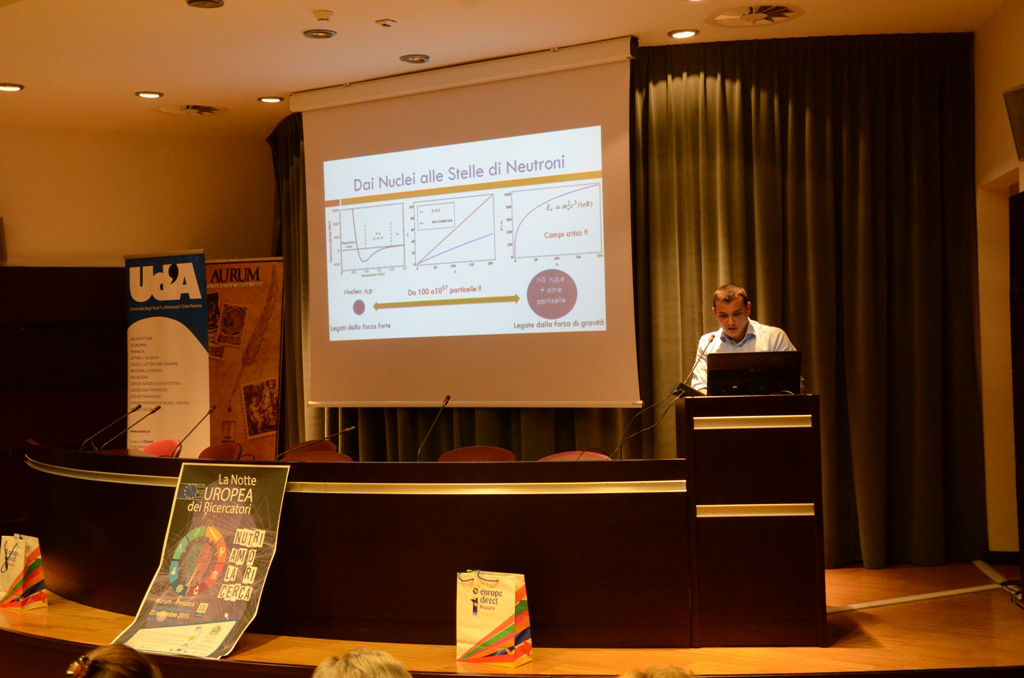
The public lectures at ICRANet and Aurum were delivered by profs. Ruffini, Rueda, Sigismondi and Dr. Arguelles and Muccino.
ICRANet center in Pescara was open for public and visitors were guided by profs. Belinski and Xue with the help of PhD students.
Recent publications and proceedings
The approach to neutron stars based on relativistic mean-field nuclear matter equations of state has been further developed and applied to rotating neutron stars. New equilibrium configurations of uniformly rotating neutron stars for selected equations of state is obtained. For these configurations it is shown that the maximum value of the dimensionless angular momentum amax/M=0.7 is independent of the equation of state and it is well below the limiting value of the Kerr black hole a/M=1. This new result is in sharp disagreement with previous estimates producing amax/M very close to 1. Other characteristics of rotating neutron star such as gravitational mass, equatorial and polar radii, eccentricity, angular momentum, moment of inertia, are computed. The mass of rotating neutron star can reach the values 2.62-3.38 solar masses, depending on the equation of state. In the figure contours of constant energy density of the configuration with central value 1015 g cm-3 in the static case are shown. Applying these results in the specific case of the fastest observed pulsar PSR J1748-2446ad the lower mass bound 1.2-1.4 solar masses is obtained.
"Angular Momentum Role in the Hypercritical Accretion of Binary-Driven Hypernovae" L. Becerra, F. Cipolletta, C. L. Fryer, Jorge A. Rueda, R. Ruffini, accepted for publication in Astrophysical Journal, 2015. The induced gravitational collapse (IGC) paradigm explains a class of energetic, long-duration gamma-ray bursts (GRBs) associated with Ic supernovae, recently named binary-driven hypernovae. The scheme of a possible evolutionary scenario leading to the binary-driven hypernovae is shown in the figure on the right. The progenitor is a tight binary system formed of a carbon-oxygen (CO) core and a neutron star companion. The supernova ejecta of the exploding CO core triggers a hypercritical accretion process onto the neutron star, which reaches in a few seconds the critical mass, and gravitationally collapses to a black hole emitting a GRB. The first estimates of the angular momentum transported by the supernova ejecta, and presented and numerical simulations of the angular momentum transfer to the neutron star during the hyperaccretion process is performed in full general relativity. It is shown that the neutron star: i) reaches in a few seconds either mass-shedding limit or the secular axisymmetric instability depending on its initial mass; ii) reaches a maximum dimensionless angular momentum value; iii) can support less angular momentum than the one transported by supernova ejecta, hence there is an angular momentum excess which necessarily leads to jetted emission. The figure on the left shows the velocity field of the supernova ejecta with a characteristic cavity which forms due to the presence of the neutron star. 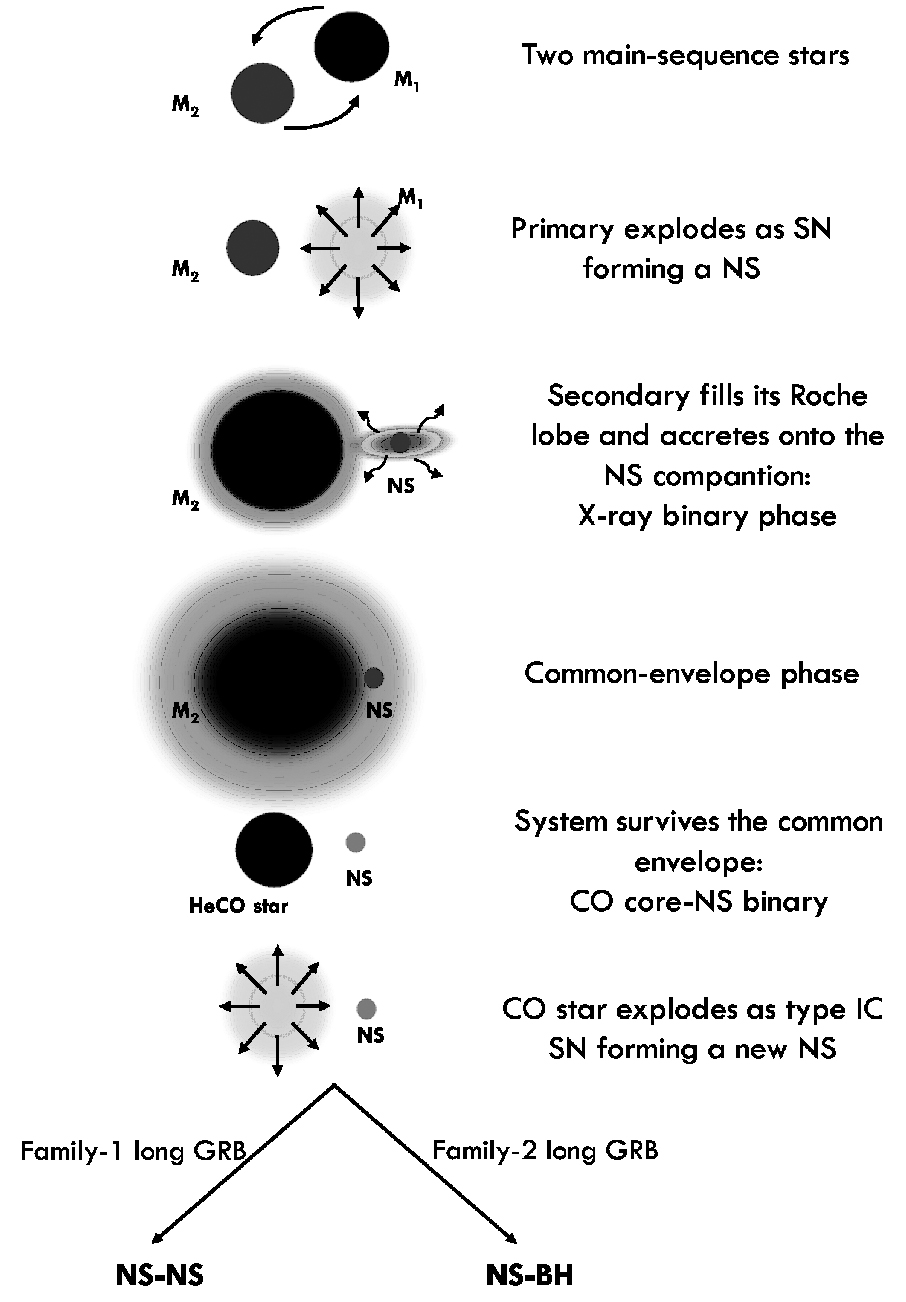
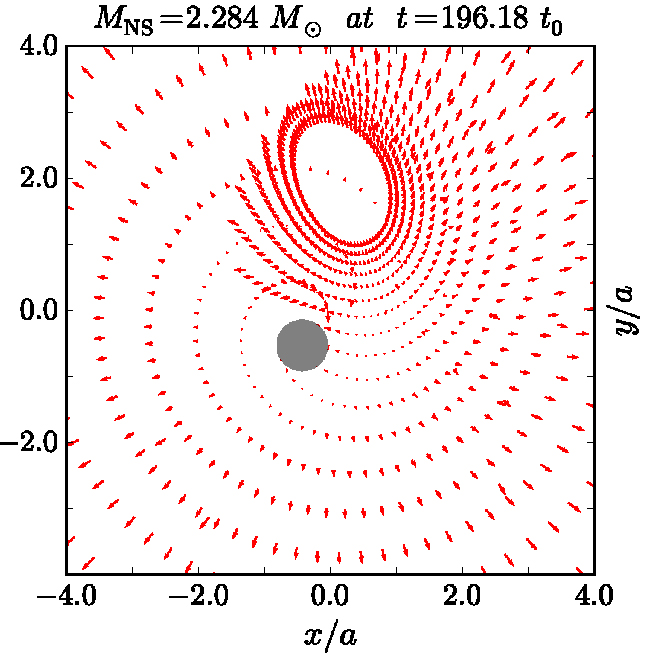
"GRB 140619B: a short GRB from a binary neutron star merger leading to black hole formation" Ruffini, R.; Muccino, M.; Kovacevic, M.; Oliveira, F. G.; Rueda, J. A.; Bianco, C. L.; Enderli, M.; Penacchioni, A. V.; Pisani, G. B.; Wang, Y.; Zaninoni, E., The Astrophysical Journal, Volume 808, Issue 2, article id. 190, 14 pp. (2015). "New measurements of Omega_m from gamma-ray bursts" Luca Izzo, Marco Muccino, Elena Zaninoni, Lorenzo Amati, Massimo Della Valle, accepted for publication in A&A, 2015. "How universe evolves with cosmological and gravitational constants in the field theory of Einstein–Cartan gravity" She-Sheng Xue, Nuclear Physics B897 (2015) 326–345.
The proceedings of the MG14 Meeting
The proceedings of the Fourteenth Marcel Grossman Meeting on General Relativity edited by Massimo Bianchi, Robert T Jantzen, Remo Ruffini will be published by World Scientific, Singapore, 2016 for the first time as an e-book with unlimited open access, they will have much more impact than the paper proceedings of the past as well as allow color graphics and more generous contribution page limits. For information please see http://www.icra.it/mg/mg14/proceedings.htm
The proceedings of the IK14 Meeting
The proceedings of the 14th Italian-Korean Symposium on Relativistic Astrophysics held on July 20-24, 2015 in ICRANet Headquarters in Pescara, Italy, will be published together with the MG14 proceedings in the same e-book.
Upcoming Conferences
The 1st Colombia-ICRANet Julio Garavito Armero Meeting
Bucaramanga, November 23-25, Bogotá, November 26-27 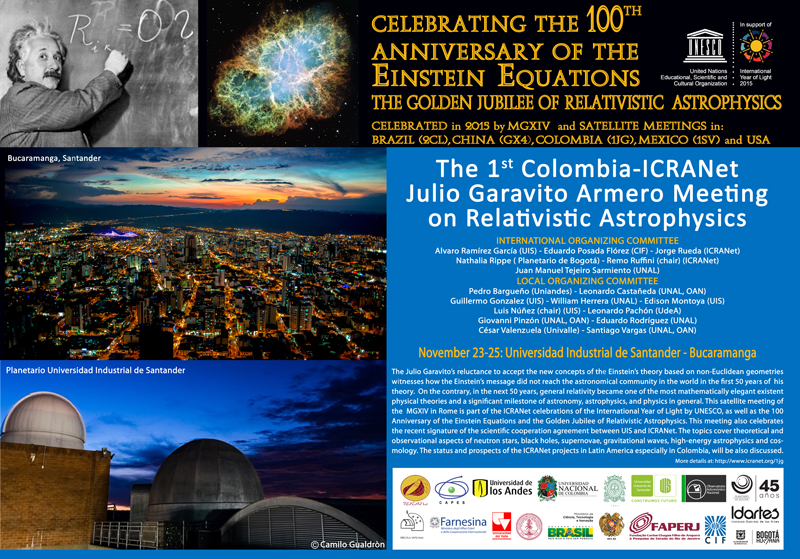
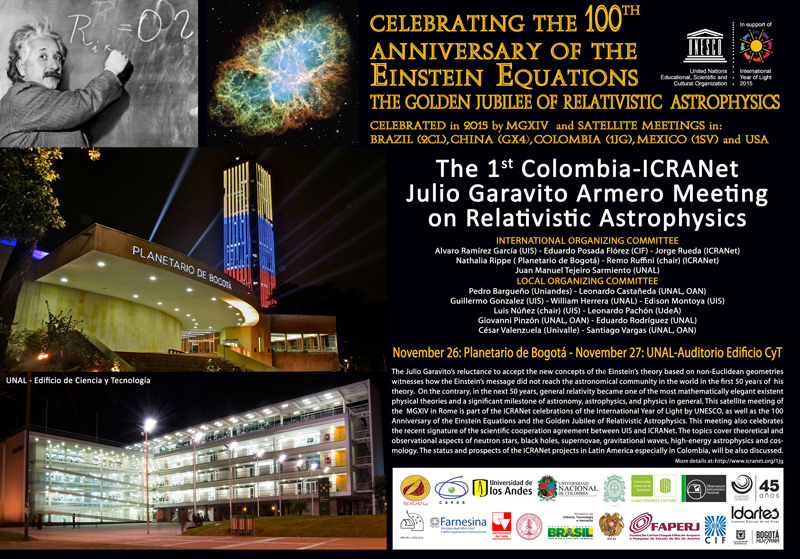
It is particularly special to dedicate this scientific meeting to Julio Garavito, the most recognized Colombian astronomer, and whose memory was honored by the International Astronomical Union by assigning his name to one of the Moon's craters. Garavito’s reluctance to accept the new conceptual ingredients of the Einstein’s theory based on non-Euclidean geometries helps us to witness how, the Einstein’s message did not reach with success the astronomical community in the world in the first 50 years of general relativity. On the contrary, becoming probably one of the most mathematically elegant existent physical theories, The General Theory of Relativity has become a significant milestone of not only astronomy and astrophysics, but of physics in general. This meeting celebrates as well the recent signature of the scientific cooperation agreement between the Universidad Industrial de Santander (UIS) and ICRANet and will take place from the 23 to the 25 November at UIS in Bucaramanga, and from the 26 to the 27 November at the Universidad Nacional de Colombia in Bogotá. The meeting will cover theoretical and observational aspects of neutron stars, black holes, supernovae, gravitational waves, high-energy astrophysics, and cosmology. The status and prospects of the ICRANet projects in Latin America, with special emphasis in Colombia, will be also discussed. International Organizing Committee: J. A. Rueda, ICRANet, R. Ruffini (chair), ICRANet Local Organizing Committee: Pedro Bargueño, Uniandes Leonardo Castañeda, UNAL – OAN, Guillermo Gonzalez, UIS, Eduard Alexis Larrañaga, UNAL-OAN, Edison Montoya, UIS, Luis Nuñez (chair), UIS, Giovanni Pinzón, UNAL- OAN, César Valenzuela, Univalle, Santiago Vargas, UNAL – OAN. Registration fee: 100 euro A few support for travel and/or living expenses and registration fee will be available for some of the local students presenting oral/poster contributions. The web page of the meeting: www.icranet.org/1jg
1st Sandoval Vallarta Caribbean Meeting
Mexico City (Mexico) - November 30-December 3, 2015 
The meeting will celebrate from 30 November to 3 December 2015 the 100th anniversary of the Einstein Equations and address the fostering of future ICRANet Scientific activities in Mexico, following the MGXIV meeting in Rome in July 2015. The scientific meeting will take place at the Auditorium Marcos Moshinsky, Instituto de Ciencias Nucleares - UNAM. The meeting will cover observational activities in the X, gamma ray and UHECR, theoretical progress in the relativistic astrophysics of Neutron Stars, Black Holes, Gravitational Waves and Cosmology as well as the development of the Brazilian Science Data Center (BSDC): from galactic and extragalactic sources and as far back in time to the appearance of the first structures in our Universe. Status and perspectives for the Mexican participation in ICRANet projects, within the IRAP PhD and EMJD Program, the associated post-docs, and presence of senior research leaders within all the ICRANet Centers will be reviewed. International Organizing Committee is chaired by R. Ruffini, ICRANet Local Organizing Committee is co-chaired by Alfredo Macías, UAM The web page of the meeting: http://www.icranet.org/1sv/ |
|||
|
||
